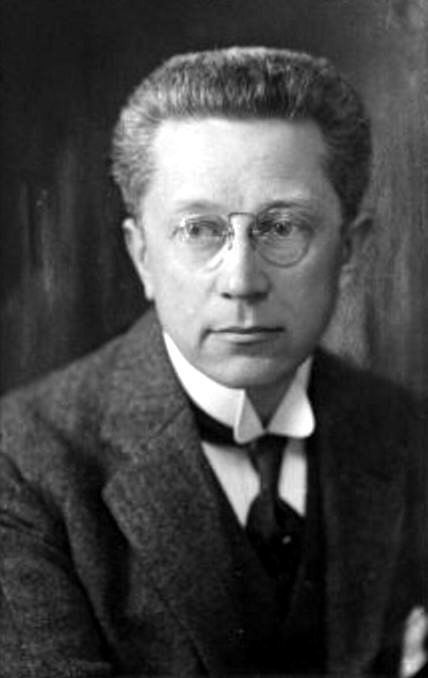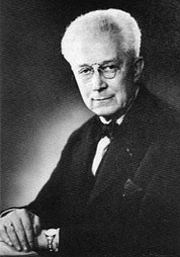Name Theodore Limperg | ||
 | ||
Théodore Limperg jr. (Amsterdam, December 21, 1879 – Amsterdam, December 6, 1961) was a Dutch accountant, and Professor in Business economics at the University of Amsterdam. He is particularly known for his contribution to the international debate about replacement costs in the 1920s.
Contents
Biography
Théodore Limperg was born late 1879 as the son of Theodorus Limperg, chief administrative officer in Amsterdam, and Mathilda Speijer. Because his father's first name and his were almost alike, he called himself Th. Limperg jr. throughout his life. He graduated in 1897 at the Commercial High School, and in 1900 obtained a teaching licence in accounting. In the same year he started his training to become Chartered Accountant at the Dutch Institute of Accountants (Nederlands Instituut van Accountants NIvA), predecessor of the Nederlands Instituut van Registeraccountants (NIVRA), and acquired his degree in 1904.

Limperg had started working as assistant accountant to gain practical experience. In 1901 he was admitted to the Netherlands Institute of Accountants, and joined the accountancy firm Volmer & Co as member. Some years later with his younger brother, who had become auditor, he founded the firm Th. and L. Limperg. This company merged in 1970 with Moret, De Jong & Starke to Moret & Limperg, which eventually merged into Ernst & Young. In 1922 Limperg was appointed Professor of Business Economics at the Municipal University of Amsterdam, nowadays University of Amsterdam. He ended his work as practicing accountant at the firm Th. and L. Limperg. In addition to his professorship he served in various administrative and advisory positions.
During World War II within the Senate of the Municipal University of Amsterdam, he was one of the leading figures in the resistance against the Germans. He was dismissed from his post in April 1943 and was forced into hiding. His son, the architect Koen Limperg, belonged to the resistance group that organised the attack on the Amsterdam Resident registration office in 1943. He was later captured and executed 1 July 1943 in Overveen.
After the Liberation Limperg took up his professorship again, and served another five years until his retirement in 1950.
Limperg married twice: In 1906 with Emma Altink (deceased in 1947), and in 1953 with Marguerite Isabelle Marie Goossens. He had three children. Besides Koen he had a son Theo, who was a lawyer and specialized in copyright law, and a daughter Emmy, first economics teacher and later lecturer in Wageningen.
Work
Limpergs ideas on accountancy in general are considered of great significance for the development of accountancy and business economics in The Netherlands. However, he sparingly published. His collected works was largely compiled from college notes made by his disciples. Limperg's economic theories have become known through the writings of his students, especially through the work of Salomon Kleerekoper. Limperg has been named 'patriarch of the Dutch accountants.' The cornerstone of his work was his theory about replacement value.
Accountancy
Limperg wanted to bring the accountancy practice and theory on a higher level. He published a series of articles starting in 1905 in the newly established Accountancy journal about the future direction of the profession, and its requirements. Another focus was on the relationship between accountancy and society. Limperg argued, that auditor reports should not only be prepared for direct clients, but for anyone who wants to take notice.
In 1905 he became editor-in-chief at the Accountancy journal. In his articles he criticized the Nederlands Instituut van Accountants NIvA (Dutch Institute of Chartered Accountants), of which he was a member as well. The institute didn't take this for granted. When the board of the institute came into conflict with a fellow member, J.G.Ch. Volmer, Limperg chose his side. In 1906 Limperg was disbarred by Niva-governance. Many other members followed his example and stepped down. In the same year these dissidents jointly founded the Nederlandsche Accountants-Vereeniging NAV (Dutch Accountants Institute).
In the years following Limperg would shape the organization a model accountancy organization. The Accountancy journal became the prime magazine of the association. The Nederlandsche Accountants-Vereeniging upheld stringent entrance requirements, and conducted its own examinations. A disciplinary board supervised the conduct of its members. The Nederlandsche Accountants-Vereeniging eventually merged into the Nederlands Instituut van Accountants in 1919. With the merge the new methods, quality standards for membership and the disciplinary board, became standard practice.
In 1923 after a dispute with the publisher Limperg started a new monthly accountancy magazine, entitled Maandblad voor Accountancy en Bedrijfseconomie (MAB), which still exists nowadays.
Trade Education
Beside the accountancy profession, Limperg campaigned for quality improvement of the Dutch business education and trade education on an academic level in a separate university. In 1913 he got his way, when in Rotterdam the Netherlands School of Commerce was founded, which in 1973 became the Erasmus University Rotterdam. In 1921 in the University of Amsterdam a new Faculteit der Handelswetenschappen (Faculty of Trade science) got started, which would become the Faculty of Economics and Econometrics.
Limperg would bear his mark on the organization and growth of the new faculty. He proposed additional auditor training, which started in 1929, and proposed to change its name to Faculty of Economics, which was implemented in 1935.
Replacement value
In his days, buildings, machinery and inventories on the balance sheet were traditionally validated based on historical costs; the costs paid to produce or to purchase the item. Another, better picture of the value can be determined based on replacement costs; the price one would pay to produce or to purchase the item. As a consequence, the assets of the company should be regularly reassessed. That provides a revaluation reserve, which is part of the equity.
This idea didn't originate from Limperg, but he did further develop the concept. His ideas had a decisive influence on the method of cost calculation and determination of profit in several Dutch companies, including Philips.
The Dutch legislation offers a choice between valuation at historical cost or valuation at replacement cost. Even after the introduction of the International Financial Reporting Standards (IFRS) for listed companies that still applies. Under International Financial Reporting Standards, the company is required to pay for the replacement of the value to be taken. For equipment they may continue to use the replacement cost.
Notable students of Limperg
Some of the most noted students of Limperg.
Because many proponents of Limperg's theories taught at the University of Amsterdam (like Limperg himself), they are often called the "Amsterdam School" of accountancy.
Political views
Limperg can be seen in many ways as a social democrat. He didn't emphasize his political views too much, to uphold his position as scientist, but he was politically engaged. In November 1938 he co-authored with fourteen others (among them the later Minister of Finance Piet Lieftinck), an open letter to the government regarding the policy of public finance. The manifesto opposed the conservative politics promoted by the direct advisers to the government, and called for a more active economic policy. Limperg also espoused the Plan van de Arbeid (Labor Plan), a plan to combat the economical crisis, drawn up by Hein Vos and Jan Tinbergen in the early thirties.
After the Second World War Limperg took a seat in the Board of Trustees of the scientific department of the Nederlands Verbond van Vakverenigingen (Dutch Trade Union Confederation).
Recognition
The work of Limperg received much acknowledgements. In 1935 he was appointed honorary president of the Comité International de l'Organisation Scientifique. The Netherlands School of Commerce (now Erasmus University Rotterdam) awarded him an honorary doctorate in 1947. In 1950 he received the Wallace Clark Medal for his international contribution to scientific management.
The Dutch inter-university institute for accountancy bears his name: Limperg Institute. This institute, in which five universities and the Nederlandse Beroepsorganisatie van Accountants (NBA), the Dutch association of auditors, cooperate, coordinates the Dutch postgraduate accountancy courses. The Institute organizes the annual Limperg Day, where the Limperg Medal is awarded to an individual, who has made a significant contribution to scientific research in the fields of accounting and auditing.
